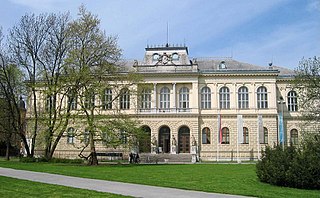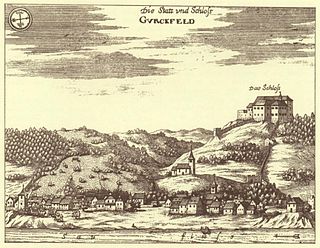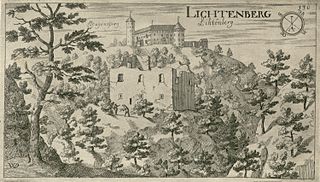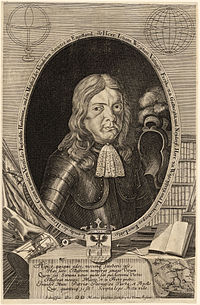
The Glory of the Duchy of Carniola is an encyclopedia published in Nuremberg in 1689 by the polymath Johann Weikhard von Valvasor. It is the most important work on his homeland, the Duchy of Carniola, the present-day central part of Slovenia.

Lake Cerknica is an intermittent lake in the southern part of the Cerknica Polje, a karst polje in Inner Carniola, a region in southwestern Slovenia. The lake, oriented in the Dinaric direction from northwest to southeast, is present for the most part of the year. When full, it is the largest lake in the country. The plain is surrounded by the Javornik Hills to the south and Slivnica to the north, both belonging to Dinaric Alps. The area of the lake mainly reaches 28 square kilometres (11 sq mi), but can reach up to 38 km2 (15 sq mi) and the surface level varies from 546 m (1,791 ft) to 551 m (1,808 ft) above sea level. The lake is an important wildlife resort, especially as a nesting place for many bird species. Botanically, it is distinguished by amphibious plants. It is therefore a part of two Natura 2000 areas of protection and the focus of the Inner Carniola Regional Park, which covers additional Natura 2000 areas in the broader region. The climate in the area is continental, with a mean temperature of 9.2 °C (48.6 °F) and the annual precipitation about 1,700 millimetres (67 in). The largest settlement at the border of the lake is Cerknica, located north of the lake. Various watersports, including rowing, are popular on the lake.
Postojna Cave is a 24.34 km (15.12 mi) long karst cave system near Postojna, southwestern Slovenia. It is the second-longest cave system in the country as well as one of its top tourism sites. The caves were created by the Pivka River.

The National Museum of Slovenia is located in Ljubljana, the capital of Slovenia. It is located in the Center district of the city near Tivoli City Park. Along with the Slovenian Museum of Natural History, located in the same building, the National Museum of Slovenia is the country's oldest scientific and cultural institution. The museum has an extensive collection of archaeological artefacts, old coins and banknotes and displays related to the applied arts. In 2021 it's been given the golden Order for Exceptional Merits by the president of Slovenia, Borut Pahor.

St. James's Parish Church is a church in Ljubljana, the capital of Slovenia. It is dedicated to St. James the Greater. Its name is often incorrectly translated as St. Jacob's because Slovene, like many other languages, uses the same word for both James and Jacob.
Hans Weilhammer was a sixteenth-century politician in Slovenia when the country was under the Holy Roman Empire. Weilhammer may have come to Ljubljana from Salzburg. He became mayor of Ljubljana in 1536 and was the first mayor to serve a term of eight years, double the previous longest term. He was succeeded by Volk Gebhardt in 1544.
Nanos is a karst limestone plateau at the eastern border of the Inner Carniola in southwestern Slovenia.
Gracar Turn is a 14th-century castle on the northern outskirts of Hrastje in the Municipality of Šentjernej in the traditional region of Lower Carniola in southeastern Slovenia.
Izlake is a settlement in the Municipality of Zagorje ob Savi in the Central Sava Valley, central Slovenia. The area is part of the traditional region of Upper Carniola. It is now included with the rest of the municipality in the Central Sava Statistical Region.

Krško Castle is a 12th-century castle ruin to the right of the Sava above the old center of the town of Krško, southeastern Slovenia. It stands in the territory of the settlement of Cesta. The castle and town are both named after the nearby Krka River.

Kozjak Castle is a 13th-century castle ruin on a rocky hill above the village of Dolenje Selce near the town of Dobrnič, part of the Municipality of Trebnje in Lower Carniola, Slovenia.

Bogenšperk Castle is a 16th-century castle located in the Municipality of Šmartno pri Litiji in central Slovenia. It is best known for its association with the 17th-century scientist and natural historian Johann Weikhard von Valvasor, a fellow of the Royal Society in London.

Lihtenberk Castle is a 13th-century castle ruin located in the Municipality of Šmartno pri Litiji in central Slovenia, directly adjacent to the later Bogenšperk Castle. It is best known for a minor association with the 17th-century historian Johann Weikhard von Valvasor, who owned the ruin and styled himself "von Lichtenberg."

Virgil von Graben, also Virgil vom Graben, was an Austrian noble, politician and diplomat. He was one of the most important noblemen and officials in the County of Gorizia and in the Habsburg Empire of Frederick III. and Maximilian I.

Medija Castle is a castle ruin located in the southern part of the settlement of Podlipovica, west of Izlake, in the Municipality of Zagorje ob Savi, central-eastern Slovenia. The castle and its stables were destroyed by the Yugoslav Partisans during World War II. The castle chapel was later restored and now serves as a venue for plays, concerts, and other cultural events, as well as weddings.
Ulrich II von Graben was a Styrian noble, a member of the edelfrei Von Graben family. He held the titles as Lord of Kornberg and Graben, as well as burgrave of Gleichenberg, Rothenfels and Hohenwang.

Šmarčna is a settlement on the right bank of the Sava River in the Municipality of Sevnica in east-central Slovenia. The area is part of the historical region of Lower Carniola. The municipality is now included in the Lower Sava Statistical Region. The settlement includes the hamlet of Gomila.

Johann Ludwig Schönleben was a Carniolan priest, rhetorician, and historian.
Konrad Adam Glušič, was a clergyman and bishop of the Roman Catholic Archdiocese of Ljubljana. He was born in Komen or near Gornji Grad. He was appointed bishop in 1571. He died in 1578.

Ulrich I von (vom) Graben was a burgrave and knight from the Austrian Herren von Graben family


















